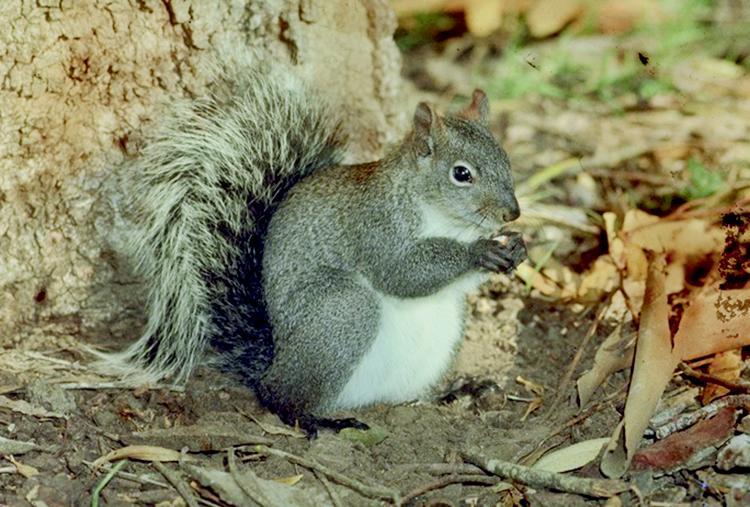With our free press under threat and federal funding for public media gone, your support matters more than ever. Help keep the LAist newsroom strong, become a monthly member or increase your support today.
Squirrels Are Eating All Of My Backyard Fruit! What Can I Do?

Like many backyard gardeners, I’ve been waiting months for tiny little plums and peaches to plump up and ripen as the weather warms; all so I can stand in my yard and take a nice juicy bite of a perfect summer fruit.
But, like many of you, each morning I’ve gone out to commune with my slowly growing stone fruits, only to find that someone else took a bite out of them first.
Admittedly, a few unripe peaches have been eaten by my 3-year-old, but squirrels are the ones doing the real damage, challenging my sanity by taking single bites of the fruit and then throwing them to the ground.
It’s enough to drive someone to want to commit squirrel murder.
While I’m not personally inclined towards that, I do want to know what my options are.
Meet who’s eating your fruit
There are a number of different squirrel species in Southern California, but your fruit munching culprit is likely the Eastern fox squirrel, particularly in the more developed areas of Los Angeles.

It’s an invasive species that’s been steadily displacing the native Western gray squirrel, which may also be present in your yard.

There’s a possibility that native California ground squirrels are taking a bite out of your crop, as well. You can identify them by their tails, which aren’t as bushy as the aforementioned squirrels that live in trees. You might be tipped off to a ground squirrel problem on your property if you’ve got holes all over your yard. Besides damaging fruit trees, their burrowing can compromise the soil that your home sits on.

It’s important to remember that even though we might see some of these squirrels as pests, they can play critical roles in ecosystems. For instance, ground squirrel holes offer much needed housing for the rapidly disappearing burrowing owl.
You may just need to pay the fruit tax
“Net the tree,” said master gardener Florence Nishida. “If you keep your fruit tree at eight feet or 10 feet, you will still get enough fruit. You can control disease better. You can certainly harvest better. It’s also easier for animal control.”
She suggested throwing a nylon covering over the tree as the fruit is developing, making sure to tie it off at the bottom so rodents don’t get in. But anticipate mice and squirrels chewing holes through the cover, she said.

Joanna Glovinsky, founder of Frutistitute, a fruit tree care and education service with about 1,400 clients across L.A. County, finds herself talking to them about squirrels quite often.
“The foolproof way is you have a cage,” says Glovinsky. A wooden frame box with chicken wire placed over the tree can do the trick, as squirrels can’t get through. Her more passionate clients have taken to building entire structures — fruit tree ADUs if you will — to protect their precious crops.
Ultimately, she says, “My answer is — accept it.”
“There’s no getting around the fruit tax,” said Glovinsky. “Critters are part of the equation and if you’re going to grow fruit, you’ve got to pay the tax.”
The first few years of a tree’s life, understand that varmints are going to pick off your paltry crop. But by the time the tree reaches four or five years old, it’s generally producing enough fruit for everyone.
Can owls help?
I asked raptor expert Peter Bloom if there were any large birds of prey that we might be able to attract that could pick off the squirrels for us.
“If you’re specifically targeting ground squirrels, attracting a great horned owl in the neighborhood would be the most advantageous,” said Bloom.
“In the early evening and at dusk, the great horned owl and the squirrels cross paths and they will take a ground squirrel that is presenting itself at an appropriate location.”
You can attract the owls by installing an artificial nest in a tree, about 30 to 60 feet off the ground. If tree squirrels are the problem, traps might be your best bet.
Red-tailed hawks, Cooper's hawks and red shouldered hawks can pick off small ground squirrels, but it’s tough to attract them without completely retrofitting your neighborhood with things like tall, welcoming trees.
“It’s a major habitat change. Not something we can do and expect immediate success. Maybe 10 years down the road,” said Bloom.
Barn owls are the easiest to attract, but won’t be of much help with squirrels, because they don’t take them and are strictly nocturnal. Meaning, when they’re out hunting, squirrels are often sleeping.
What about more lethal methods?
Some of you may be inclined to kill the squirrels eating your fruit. According to the California Department of Fish and Wildlife, you can in some circumstances.
If it’s a native gray squirrel you need to get a special depredation permit from the state to remove them. But if it’s one of the red fox squirrels, you do not need a permit.
Call the South Coast regional CDFW office at (858) 467-4201 for a consultation with a biologist who will be able to advise you, and potentially help you get a permit if one is needed.
The most effective way to kill off squirrels is with a kill trap. However, it’s important to remember that other squirrels are likely to move in, especially if you have wonderful sources of food.
If you’re considering trapping them alive, just know that it’s illegal in California to move them to another location. So, you’re going to have to euthanize them using what are considered humane methods, which include gassing with carbon dioxide or by shooting them (if legal in your area). Drowning (which one person told me they did) is illegal.
Don't use poison, as it can then kill other animals that may be inclined to eat dead squirrels.
They can be hunted during hunting season (August through January) in some locales, though not in any coastal counties from Santa Barbara, south.
It’s illegal to fire a gun, bb gun or air rifle in the city of Los Angeles, so keep that in mind if you think you’ll just shoot them.
If you don’t want to kill the squirrels yourself, you can hire a licensed pest control company.
Be careful handling squirrels because they can carry diseases, including the bubonic plague.








